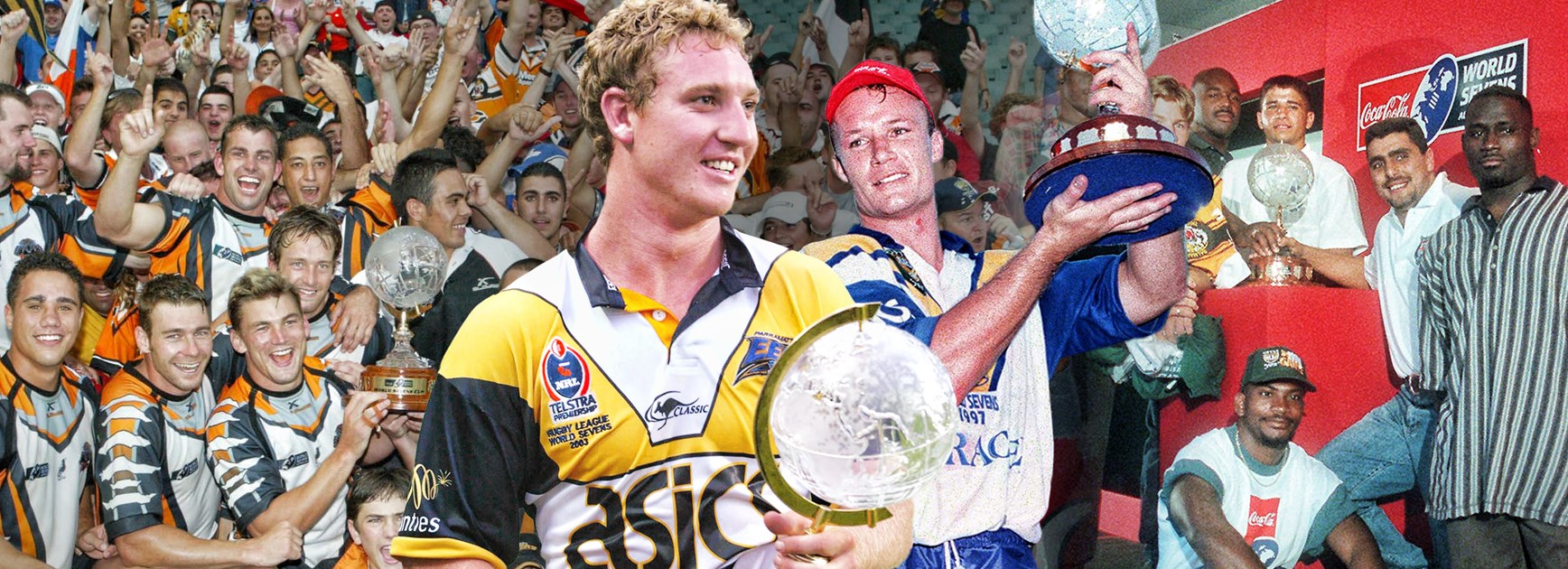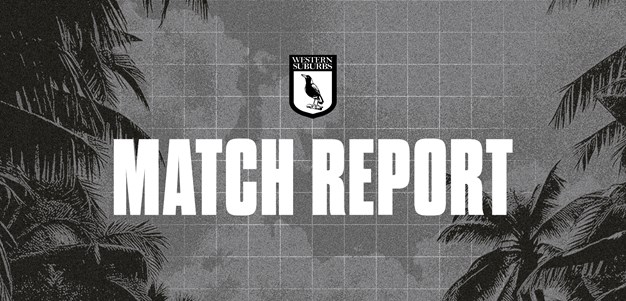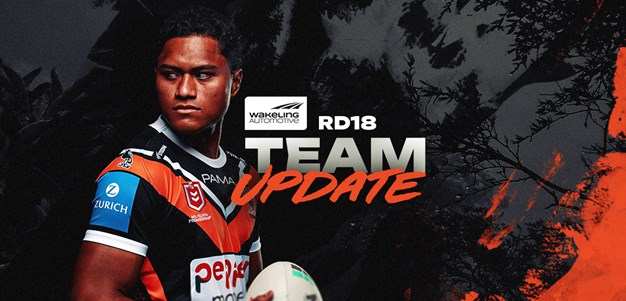
Despite the Auckland Nines seeming like a flashy new concept in 2014, short-form rugby league has been around for much longer.
Rugby league sevens has been around in some format almost as long as 13-a-side, but the first structured tournament was introduced in 1961.
An annual club sevens ran from 1988 to 1997, then again in 2003 and 2004. Super League brought in a World Nines tournament which ran in 1996 and 1997, competing with 1997's ARL-aligned World Sevens.
That was it for structured short-form rugby league until its triumphant 2014 return in Auckland, with four madcap years of club nines followed by another short hiatus, until last year's World Nines and the impending NRL Nines in Perth.
Pre-history, rugby league meets royalty, a historic year
Records are sketchy around short-form rugby league in the embryonic years of the code and its split from rugby, which had was played in a sevens form as early as the 19th century.
Rugby league sevens hit the big time in 1933, when 80,000 people – including the royal family – attended a match between Australia and England at Leeds. 'The Rugby League News', a precursor to 'Big League' that was published from 1920 to 1954, reported on August 26 of the Australia team selections:
The players to watch in the NRL Nines
"With [Fred] Gardiner's eye cut, [Fred] Neumann's leg 'heavy', [Les] Mead with boils, [Fred] Gilbert with an ulcerated leg, and [Melville] Glasheen with influenza, the managers of the 'Kangaroos' sat for an hour to-day selecting seven to play England's international seven-aside at Leeds on Wednesday when the King and Queen Visit Roundhay Park."
Australia went on to win 29-11.
The next notable short-form iteration came nearly three decades later, in 1961. The same year the first televised rugby league game hit screens, a testimonial event for retiring Western Suburbs and Australia halfback Keith Holman brought Sevens back to the rugby league calendar with the NSWRL clubs facing off over a weekend.
In their book, Great Australian Sporting Stories, journalists Ian Heads and Norman Tasker recalled a then-40-year-old Brian Bevan pulled on the jersey for his debut club, Easts, having scored almost 800 first-grade tries for Warrington and Blackpool over a two-decade career.
Despite his age, the future Hall of Fame member scored five "dazzling" tries to be named player of the tournament.
Modern era – sevens joins the calendar
The first regular appearance of sevens in the rugby league landscape came in 1988, with a pre-season club sevens tournament running every year through to 1997 (then again in 2003 and 2004) featuring the NSWRL/ARL/NRL clubs.

Held at Parramatta Stadium for three years as a knockout tournament, the fixture moved to the SFS in 1992 and included group stages and finals with overseas teams being invited.
Manly with three wins (1990, 1994-5) and the Eels with two (1997 and 2003) were the only multiple winners, with Souths (1988), Balmain (1989), Newcastle (1991), Wigan (1992), Easts (1993), Newcastle (1996) and Wests Tigers (2004) the other champions.
With plenty of stars like Steve Menzies, Des Hasler, Geoff Toovey, Matt Ridge, Terry Hill and John Hopoate in action in 1994-5, it's no surprise Manly were far too good for Fiji and St George in their respective finals.
Wigan were the only overseas winners through the history of the tournament. Widely written off after barely scraping through the group stages in 1992, the Cherry & Whites romped through the finals and easily downed Brisbane in the decider as legendary England speedster Martin "Chariots" Offiah ran in four tries at a saturated SFS.
Club favourites set to ignite NRL Nines
"The World Sevens was a lot of fun," Broncos star Steve Renouf told NRL.com.
"I think I played in the majority of those tournaments. At the Broncos we just treated it as a bit of a run, we never won anything really but got beaten by Wigan in the final.
"Martin Offiah, you just realised how quick he was. That final was a quagmire. We struggled, Mick Hancock and I, Chariots just ran around us. It was like running on water, we couldn't get near him."
Other overseas participants through the years included Fiji, Tonga, Samoa, PNG, Russia, South Africa, USA and Japan. A New Zealand side competed as Wainuiomata.
The Eels went 'back-to-back' either side of the hiatus in '97 and '03, with Nathan Hindmarsh, Dean Widders and Luke Burt among the stars in '03.
The Tigers' '04 success heralded their free-spirited run to the 2005 premiership with a very young pair of future stars in Benji Marshall and Bronson Harrison playing alongside the likes of Pat Richards, Daniel Fitzhenry, Mark O'Neill and Shane Elford.
It was the last time short-form rugby league held a place at the top level in Australia until the 2014 Auckland Nines, and the last time top-level Sevens was held at all.
"I was actually in the Parramatta [Sevens] team in 2003 as well but I hurt my ankle on the first day," Richards recalled.
"The 2004 [tournament] was my first games with the club. We ended up going on and winning, we had a great young squad with a young Benji Marshall in the team. He came out and everyone took notice because what he was doing was just unbelievable."
Super League breakaway introduces Nines
The schism that tore apart rugby league in 1996-1997 had flow-on effects for short-form rugby league, with Super League clubs not included in the Sevens tournaments for those years and instead introducing its own Super League World Nines.
There were 16 nations in 1996 and 12 in 1997 that contested the pre-season tournaments in Suva and Townsville, respectively.
The Australian sides were made up of only Super League-aligned players, with the star-studded Broncos and Raiders making up the bulk of the squads.
New Zealand – able to field its cohort of Super League-aligned Auckland Warriors players such as Stacey Jones, Stephen Kearney, Sean Hoppe and Matthew Ridge – won both tournaments.

Despite boasting names like Laurie Daley, Ricky Stuart, Steve Walters, Steve Renouf, Wendell Sailor, Glenn Lazarus, Andrew Ettingshausen, Brett Mullins and Michael Hancock, Australia were unable to make either final with PNG (1996) and Western Samoa (1997) the two runners-up.
Kangaroos star Steve Renouf recalled the cyclone around Fiji in 1996 had the players more concerned for their welfare than winning footy games, with one day of the tournament abandoned.
"There was a cyclone bearing down," Renouf told NRL.com.
"No-one was really sure what was happening, we thought 'we'll just buckle down', there ended up being a lot of rain and we got out of there just before anything bad happened."
Renouf also recalled the Australian team not quite being able to match it with the Kiwis despite an all-star line-up.
"I think we got rolled by New Zealand both times, it was one of those things," Renouf said.
"Then in Townsville in '97, Tim Sheens was the coach that year, once again we came up against the Pacific Island teams and they played very well.
"I got knocked out in our last game, I collected someone's knee and it was lights out.
"Like in '96 it was just good to get together with the guys in a different format. We had a fair team, maybe we had a bit too much fun! New Zealand just had the wood on us at the Nines for some reason."

Nines returns in Auckland
After a 10-year hiatus, Nines returned with the 16 clubs descending on Auckland for a pre-season festival of footy. For a deep dive on those four years, check out NRL.com's look back at the Auckland Nines. The trophies were taken out by the Cowboys, Rabbitohs, Eels (later stripped) and Roosters.
After a two-year break, Nines returned as a World Cup, with Australia winning the 12-team men's tournament and New Zealand the four-team women's tournament in October.
Having played in the 2003 and 2004 Sevens then in the 2014 and 2015 Auckland Nines with the Tigers after returning from Super League, Richards is in the rare position of having played top-level Sevens and Nines in the modern era.
"Defensively you can cope a bit having nine, but seven is crazy," Richards said.
"The middle of the field, you'd only have a couple of players and a massive short side, someone fast like Benji gets one on one with someone it's game over. The two extra players makes it a different sort of game.
"In 2014, the Cowboys just defended really well and the Warriors ran out of steam. To win it you had to be able to play four games on the last day and defend well."
Which brings us to the impending return of the NRL Nines this weekend in Perth as the 16 NRL clubs and four NRLW clubs battle it out over two days.












